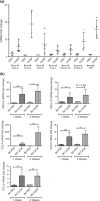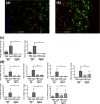CpGB DNA activates dermal macrophages and specifically recruits inflammatory monocytes into the skin
- PMID: 25425469
- PMCID: PMC4474603
- DOI: 10.1111/exd.12603
CpGB DNA activates dermal macrophages and specifically recruits inflammatory monocytes into the skin
Abstract
Toll-like receptor 9 (TLR9) drives innate immune responses after recognition of foreign or endogenous DNA containing unmethylated CpG motifs. DNA-mediated TLR9 activation is highly implicated in the pathogenesis of several autoimmune skin diseases, yet its contribution to the inflammation seen in these diseases remains unclear. In this study, TLR9 ligand, CpGB DNA, was administered to mice via a subcutaneous osmotic pump with treatment lasting 1 or 4 weeks. Gene expression and immunofluorescence analyses were used to determine chemokine expression and cell recruitment in the skin surrounding the pump outlet. CpGB DNA skin treatment dramatically induced a marked influx of CD11b+ F4/80+ macrophages, increasing over 4 weeks of treatment, and induction of IFNγ and TNFα expression. Chemokines, CCL2, CCL4, CCL5, CXCL9 and CXCL10, were highly induced in CpGB DNA-treated skin, although abrogation of these signalling pathways individually did not alter macrophage accumulation. Flow cytometry analysis showed that TLR9 activation in the skin increased circulating CD11b+ CD115+ Ly6C(hi) inflammatory monocytes following 1 week of CpGB DNA treatment. Additionally, skin-resident CD11b+ cells were found to initially take up subcutaneous CpGB DNA and propagate the subsequent immune response. Using diphtheria toxin-induced monocyte depletion mouse model, gene expression analysis demonstrated that CD11b+ cells are responsible for the CpGB DNA-induced cytokine and chemokine response. Overall, these data demonstrate that chronic TLR9 activation induces a specific inflammatory response, ultimately leading to a striking and selective accumulation of macrophages in the skin.
Keywords: cell trafficking; chemokines; inflammation; monocytes/macrophages; skin.
© 2014 John Wiley & Sons A/S. Published by John Wiley & Sons Ltd.
Conflict of interest statement
The authors have declared no conflicting interests.
Figures




References
-
- Hemmi H, Takeuchi O, Kawai T, et al. Nature. 2000;408:740–745. - PubMed
-
- Lin JH, Dutz JP, Sontheimer RD, et al. Clin Rev Allergy Immunol. 2007;33:85–106. - PubMed
-
- Marshak-Rothstein A, Rifkin IR. Annu Rev Immunol. 2007;25:419–441. - PubMed
-
- Rifkin IR, Leadbetter EA, Busconi L, et al. Immunol Rev. 2005;204:27–42. - PubMed
Publication types
MeSH terms
Substances
Grants and funding
LinkOut - more resources
Full Text Sources
Other Literature Sources
Research Materials

